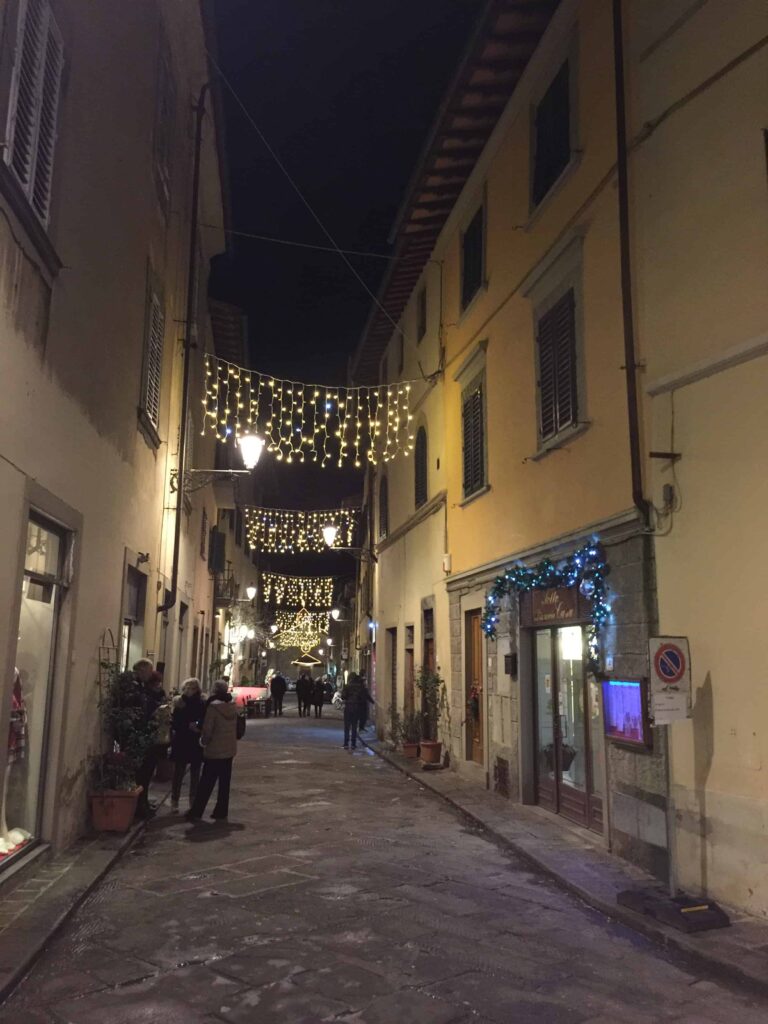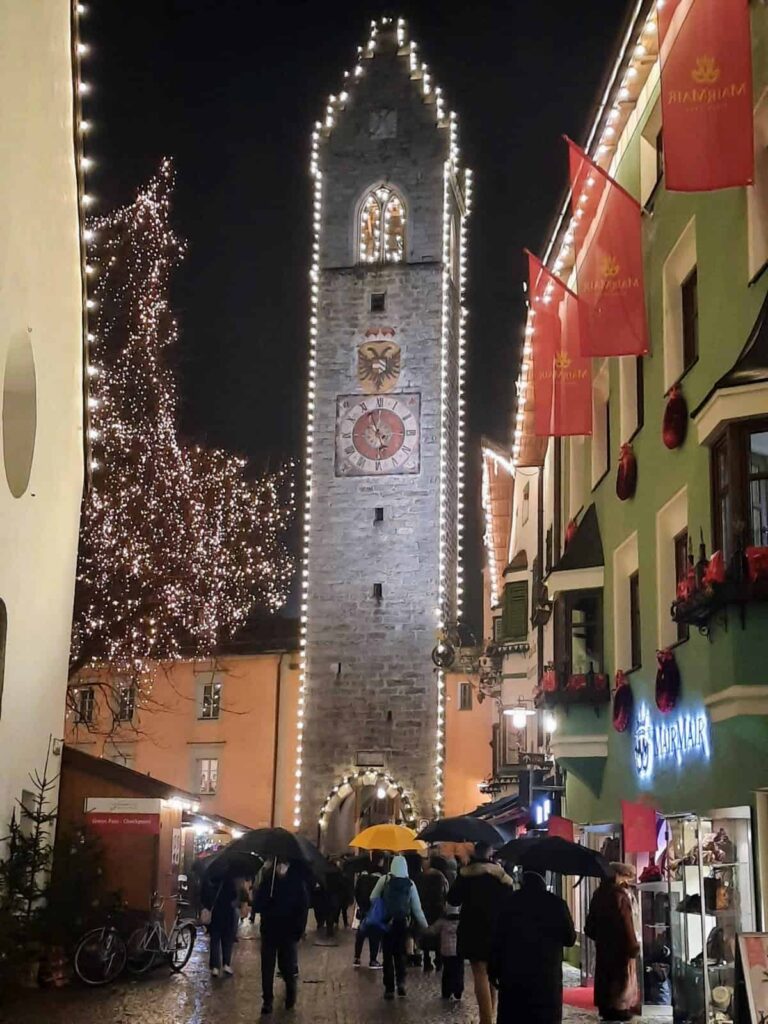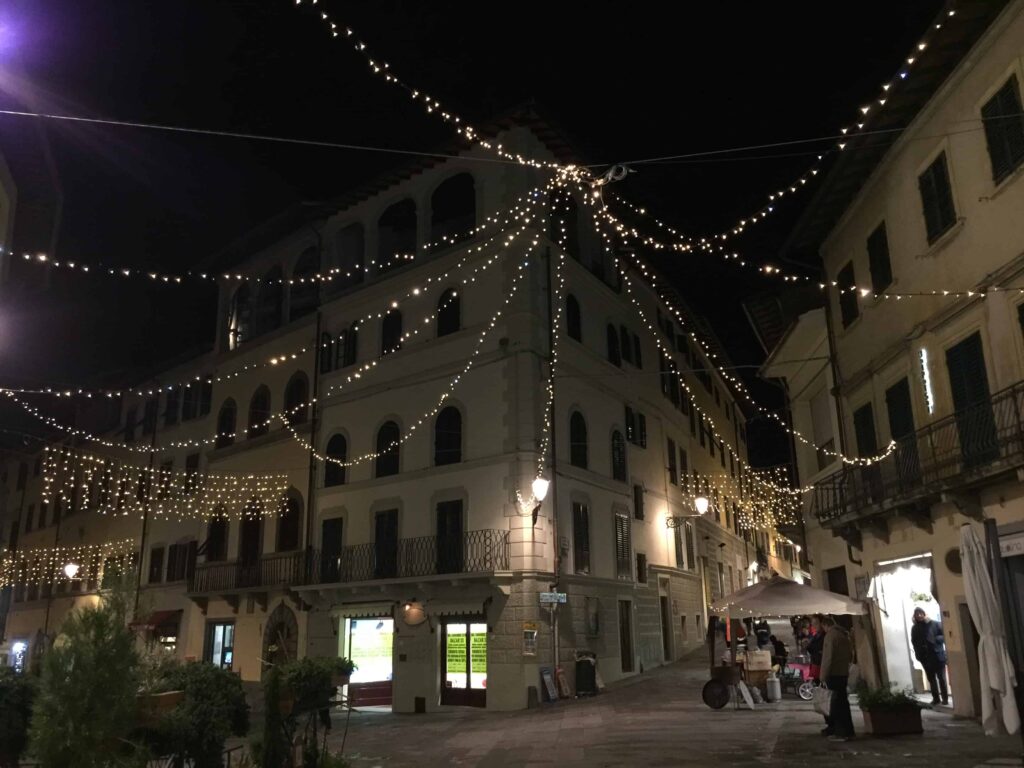Will you be celebrating Christmas in Italy? Here’s a guide of what to expect. From Italian Christmas traditions to foods and rituals, we’ve got you covered. Find out what’s open, learn how to say Merry Christmas, and learn how to pronounce important Christmas related words in Italian, like Natale.
I’ll explain what Italians do during the long Christmas season, how they celebrate, and what they eat. Not only that, find out which Christmas traditions children take part in, how long Christmas vacation is in Italy, and how to survive all the feasting!
Table of Contents
HOW TO SAY CHRISTMAS AND CHRISTMAS EVE IN ITALIAN
Christmas is called Natale in Italy, and is celebrated on December 25th. Christmas Eve is called la vigilia di Natale (the eve of Christmas). Natale derives from the Latin word for to be born.
The pronunciation of Natale and La vigilia di Natale is: nah-TAL-leh, lah vee-GEE-lee-ah dee nah-TAL-leh
Listen to how to pronounce Natale and La vigilia di Natale here:
CHRISTMAS IN ITALY: WHAT’S OPEN

On Christmas Eve (December 24th) most shops are open during the day, at least in the morning. Some may close early in the evening, so make sure to double check if you need to go shopping on Christmas Eve. The same goes for supermarkets, but try to avoid going if you can- they’re usually packed with panicked people shopping for food last minute. If you’re in a small town, people will stop to wish each other best wishes for the holidays.
On the other hand, Christmas Day is a public holiday and pretty much everything is closed, except some restaurants. Restaurants that are open will usually have a menu fisso, or fixed menu for Christmas lunch, instead of à la carte (alla carta). I absolutely recommend reserving in advance. Read more about the importance of Christmas lunch below.
You may like our post on the Best Times to Visit Italy: Month-by-Month.
THE ITALIAN CHRISTMAS HOLIDAY SEASON: LE FESTE
In Italy Christmas is not just a one off holiday. It is actually only one of a series of important Catholic holidays between the beginning of December and the beginning of January. These are called Le Feste, or The Holidays.
It starts off on December 8, which is the feast of the Immaculate Conception. It is a public holiday, so schools and most offices are closed. Most families put up their Christmas trees and their presepi (nativity scenes) to get the Christmas season going. In the region of Abruzzo, the evening of December 7 enormous bonfires are lit along the beach and in the countryside of Francavilla al Mare and surrounding towns in honor of the Madonna.
Then there is December 25 (Christmas), December 26 (St. Steven’s Day), Christmas Day (January 1), and the Epiphany, or Befana (January 6), all public holidays. Italian school children have a whopping 2 week winter break, called the vacanze natalizie or vacanze di Natale (Christmas vacation), and sometimes it’s even longer depending on which days of the week the holidays fall on.
LEADING UP TO CHRISTMAS
The Christmas hype and fanfare in Italy lasts for at least a month, from the weeks leading up to Christmas, all the way through January 6th.
CHRISTMAS MARKETS

Christmas markets, or mercatini di Natale, appear all over Italy during the Christmas season. Bancarelle, or stands, in little wooden huts line the piazza, filled with gifts, crafts, and treats to eat. The region of Trentino-Alto Adige in the Alps on the Austrian border, is famous for its mercatini, but there are plenty of big and small markets in central and southern Italy too.
LIGHT DISPLAYS AND DECORATIONS

During Christmas season time, Italian small towns and big cities alike have light displays running above and along the main streets. These lights can be quite elaborate! Usually the main piazza will also have a Christmas tree.
Some Italian towns even set up a temporary ice skating rink in the main piazza, or a ferris wheel and other fair rides. Store windows and shops inside are all decked out in Christmas decorations. It is a time to enjoy buying presents and treats.
CHRISTMAS TREES

Another Christmas tradition in Italy is a Christmas tree, or albero di Natale, set up in the piazza of almost every town. There are all different styles. Some are real trees decorated with lights and ornaments, others are made completely of lights.
Some Italian Christmas trees are traditional, others are modern. In Salerno many years ago I saw a piazza Christmas tree with ornaments made of recycled materials. In our small Tuscan town a real tree is decorated with ornaments made by children at the local preschool. According to the Guiness Book of World Records, Italy is home to the world’s biggest Christmas tree: a display of hundreds of multicolored lights that towers above Gubbio, Umbria along the side of Mount Ingino.
Italians also have Christmas trees in their homes. Most families put theirs up on December 8th, the feast of the Immaculate Conception, and decorate them with lights and ornaments. While it is not impossible to find a real tree, artificial trees are more common.
PRESEPI
A presepe, also called a presepio, is a nativity scene, an important Italian Christmas tradition. Whether made out of plastic, wood, clay or cardboard, these depictions of the manger scene can be simple or elaborate, realistic or fantastical, small or huge. Most Italians have one at home which they display right along with, and even instead of a Christmas tree. They often show an entire village, not just the manger.
Churches have their own presepi (presepes) as well. Part of the fun of the Italian Christmas season is seeking them out in small little churches and unexpected places. There are also presepi exhibitions, where you can see presepi in different styles, and from different countries and time periods.
A presepe vivente, which literally means living nativity scene, is a kind of performance where people dress up and act out a nativity scene. For example, Casole d’Elsa in Tuscany is famous for its presepe vivente. An entire portion of town is decorated and turned into an ancient backdrop, and townspeople dress up in costumes as the blacksmith, baker, weaver, and so on. Spectators feel transported into another world as they wander through the streets of town to gaze at the different scenes. The presepe vivente culminates in the manger scene with real people playing baby Jesus, Mary, and Joseph flanked by live animals.
Naples is a major destination for presepe lovers. Via San Gregorio Armeno, known as La Via dei Presepi (Presepi Street), is the place to go. Lined with displays of artisanal presepi and shops selling statues and pieces for presepi, it is a real marvel. The shops are open year round, but of course the best time to visit is during the Christmas season.
CELEBRATING CHRISTMAS AT SCHOOL IN ITALY
Italy is officially a secular country, but it is still overwhelmingly Catholic. Public school offers Catholic religion instruction, which families can opt their kids out of. However, the Christmas season pervades everything and is celebrated at public school, with Christmas-themed lessons and activities.
In nursery and primary school, children participate in a school party, recita (school play) and/or a performance of Christmas songs for parents. While it is not religious, it is a cultural celebration of Christmas. Then schools have their long vacanze natalizie, or Christmas vacation, until after January 6th.
CHRISTMAS EVE
FEASTING ON CHRISTMAS EVE

Cena means dinner, and La Cena della Vigilia (di Natale) is the Christmas Eve dinner. It is also often called il cenone delle Vigilia, which means the big dinner, or feast of Christmas Eve. In many places it is just as important as the next day’s Christmas lunch, and just as long.
It is an Italian tradition to eat fish and seafood on Christmas Eve, not meat. In every region of Italy, and even from town to town, there are different traditional fish and seafood dishes, such as spaghetti alle vongole (spaghetti with clams), anguilla (eel), baccalà (salted codfish), and polpo (octopus).
Learn more about Traditional Italian Christmas foods here.
MIDNIGHT MASS
Even for non-religious Catholics, it is important to attend la messa, or mass, at midnight on Christmas Eve, to celebrate the birth of Jesus. There, Italians wish a Merry Christmas to their neighbors and friends). Italians who are housebound can watch the Pope celebrate mass on television.
CHILDREN ON CHRISTMAS EVE
On Christmas Eve, Italian children are antsy to see if Babbo Natale, or Santa Claus, will bring them presents. For the past couple months, they have been hearing “Fate i bravi così Babbo Natale vi porta i regali” (“Be good so Santa Claus will bring you presents”). Children often set out biscotti (cookies) for him, and even carrots for the renne (reindeer).
Up until now, the ubiquitous Italian presepi, or nativity scenes, have been without the figure of Jesus. On Christmas Eve, Jesus is placed in the manger to complete the nativity scene. It is a nice tradition for the child of the family to do the honors.
However, in Italy there is an important tradition that Italian children DON’T do: put out stockings on Christmas Eve! Don’t worry, there is a whole other holiday for stockings: La Befana, or the Epiphany, on January 6th.
ON CHRISTMAS
The Italian saying Natale con i tuoi, Pasqua con chi vuoi is taken very much to heart. It means: Christmas with your family, Easter with whom you wish. Indeed, Italians traditionally spend Christmas with their family.
Christmas is often celebrated with extended family, since many Italians stick close to home. Others travel long distances to get to their native towns where their families live. Italian trains and flights are notoriously packed on the days leading up to Christmas.
Here are some Italian Christmas Day traditions:
PRESENTS
I regali, or presents, have become an important tradition in much of Italy. However, even just two generations ago it was not traditional to give gifts on Christmas in my mother-in-law’s Tuscan family, for example (presents were reserved for January 6th). Now Babbo Natale (Santa Claus) leaves gifts for children under the Christmas tree, and adults often exchange presents as well.
CHRISTMAS LUNCH
Il pranzo di Natale means Christmas lunch. It is an hours-long affair with a myriad of courses and wine. The table is beautifully set, and the meal never ends.
My first time at my Italian mother-in-law’s Christmas lunch, I cried real tears of disbelief, joy and panic as course after course was brought out to the table. I was already stuffed after the third course. I didn’t know that il pranzo di Natale is a marathon, not a sprint.
While most Italians have pranzo di Natale at home with family and relatives, some restaurants are open on Christmas. They generally serve a fixed price menu, not à la carte.
For a full rundown of what Italians eat at Christmas, read Traditional Italian Christmas foods. Here are some traditions and features of the Christmas lunch.
SPARKLING WINE
The pranzo di Natale will probably start off with a brindisi, or toast, so sparkling wine, or spumante, is a must. There are many wonderful Italian sparkling wines, most notably Prosecco and Franciacorta.
REGIONAL SPECIALTIES AND TRADITIONS
Where you are celebrating Christmas in Italy will probably determine the foods at your Christmas feast. Different regions and areas have different traditional Christmas foods.
For example, in Tuscany, the appetizers include salmon crostini (a finger food made out of a crouton topped with thinly sliced smoked salmon), and the first course is tortellini (stuffed pasta) in a capon broth, or tortellini in brodo.
Lentils are often eaten at Christmas to bring good fortune, along with zampone, a pig trotter stuffed with spiced pork made in Modena; or cotechino, a pork sausage from northern Italy. Pork was a rare treat for poor Italian peasants in the not so distant past.
DESSERTS
There are wonderful regional Italian Christmas desserts. Two of the most famous are pandoro and panettone, leavened yellow Christmas cakes. They have become popular all over Italy, though pandoro is originally from Verona and panettone is from Milan.
Pandoro means golden bread. It is tall, star shaped, and covered with powdered sugar. Classic Panettone is a dome shaped sweet bread dotted with candied fruits and raisins. Today’s bakers experiment with different sweet combinations, as well as savory versions.
LA TOMBOLA
In a post-feeding stupor, many Italian families reach for la tombola, which is like Italian bingo! Gathering around the table and playing this game is a fun way to spend the late afternoon or evening.
GEAR UP FOR THE NEXT FEASTS
While it may seem that you could never possibly eat again after il pranzo di Natale (Christmas lunch), you will discover that this is not the case. In fact, the very next day you will be back at the table with your family to celebrate Santo Stefano, or St. Steven’s Day. This often means yet another feast, even if it is with Christmas leftovers.
Not only that, the following week there is the cenone di San Silvestro (the New Year’s Eve feast). And the week after that, there is the Epiphany to celebrate on January 6th.
In order to survive, we keep citrosodina in our house. It’s an antacid that aids digestion which you can buy at the supermarket. Look for the bright yellow container.
WHAT TO SAY ON ITALIAN CHRISTMAS

When toasting and celebrating Christmas in Italy, the most common phrases to say are Buon Natale! and Auguri!
Buon Natale means (Have a) good Christmas! Use it to wish someone a Merry Christmas.
Auguri means best wishes! It is a common word to use on holidays and special occasions. Learn more about auguri in Italian.
If you’re looking for more phrases, read how to say Merry Christmas in Italian.

